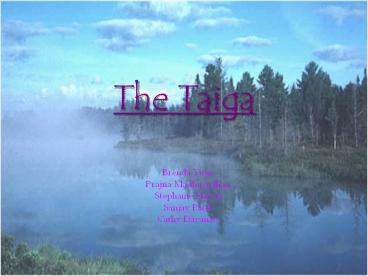The Taiga - PowerPoint PPT Presentation
Title:
The Taiga
Description:
The Taiga Brenda Yuan Prajna Madhusudhan Stephanie Harris Sanjay Patel Cathy Davanzo The Taiga Biome Also known as a coniferous forest or boreal forest Largest ... – PowerPoint PPT presentation
Number of Views:234
Avg rating:3.0/5.0
Title: The Taiga
1
The Taiga
- Brenda Yuan
- Prajna Madhusudhan
- Stephanie Harris
- Sanjay Patel
- Cathy Davanzo
2
The Taiga Biome
- Also known as a coniferous forest or boreal
forest - Largest terrestrial biome
- A subarctic, evergreen coniferous forest of
northern Eurasia located just south of the tundra
and dominated by firs and spruces. - Location Northern portions of North America,
Europe, Asia, extending southward at high
elevations
3
Climate
- The taiga climate is cold arctic air. Cold winds
bring in cold air from the Arctic Circle. - Because of earth's tilt, the taiga is turned away
from the sun in the winter. - Seasonal climate
- Long winter (6-7 months)
- Summer is rainy, hot and short
- Fall is the shortest season. Spring brings
flowers and the frozen ponds melt.
4
Climate continued
- Lowest temperature is -65F in the winter
- Highest temperature is 70 F in the summer.
- The taiga's average annual rainfall of 12 - 33
inches (30 - 84 cm). Most of it falls in the
summer as rain
5
Soil Type
- Characterized as young and poor in nutrients
- Caused by the cold, which slows the development
of soil and plants' ability to use its nutrients.
- Much humus and litter ? fallen leaves and moss
remain on the ground for a long time which limits
their contribution to the soil - Soils acidic ? acids from pine needles also
strains the soil from having more nutrients.
However, in clearings in the forest and in areas
with more trees there are more herbs and berries
growing.
6
Common Vegetation
- Coniferous trees
- Spruce
- Fir
- Pine
- Larch
- Tamarack
- Poor understory
- Deciduous tress/shrubs
- Alder
- Birch
- Aspen
7
Adaptations/Features of Plants
- Conical shape
- Promotes shedding of snow and prevents loss of
branches - Needle-like leaves
- Reduces surface area through which water can be
lost - Have thick, waxy coating cuticle again to
prevent water loss - Evergreen retention of foliage
- Allows plant to photosynthesize as soon as
sunlight is available, rather than waiting to
grow leaves - Dark color
- Helps the plants to absorb maximum sunlight
8
Animal Life
- There are 85 species of mammals, 120 species of
fish, and 32,000 species of insects - Some animals include mule, deer, moose, elk,
mice, hares, squirrels, lynx, bears, foxes,
fishers, marten, birds - Taiga has cold summers and warm winters, which of
course is a challenging biome for reptiles and
amphibians.
9
Animal Life
- Home to many large herbivorous mammals
- Animals eat heavily during summer to gain fat for
winter and have heavy layers of fur to insulate
their bodies. - Also fur is dark in the winter and light in the
summer which can help protect against predators
(snowshoe hare)
10
How people have adapted to living/working in the
taiga
- Very few people live in the taiga because of its
cold climate - Most of the taiga is unpopulated, though there
are a few large cities in the southern parts such
as Moscow or Toronto
11
How people have adapted to living/working in the
taiga continued
- Humans have adapted to working in the taiga by
using the abundant resources it produces - Logging, mining, and hydroelectric development (a
form of renewable energy where electrical power
is produced by flowing/falling water) - These activities negatively impact the biome
- Most of logging is done by clear-cutting ?
regrowth of mature forests takes a long time
because of climate and soil - Hydroelectricity seems beneficial, modifies and
disrupts the environment
12
- Opportunities
- Limitations
- Abundance of empty land
- Lots of resources to use and exploit.
- Can have peace and solitude and be by yourself
- Few cities or other forms of civilization
- Large amounts of snow and extreme weather
- Difficult for plants to grow because of the thin
and nutrient-poor soil
13
You should move to the Taiga because
- In the summer months since ground is moist plant
growth can be very rapid in this short time of
3-4 months. - Lots of trees and other resources
- If you want you can live alone and have peace and
solitude - However, there are also a few large cities if you
prefer a more metropolitan lifestyle
14
Before moving, please consider
- Harsh weather in the Taiga
- Huge range of temperatures, from very cold for a
long period of time to hot temperatures. - Steady amounts of precipitation (in small
amounts) throughout the year but in the winter
it is only snow. - Due to the permafrost, you cannot grow many types
of crops because of the frozen soil
15
the end































